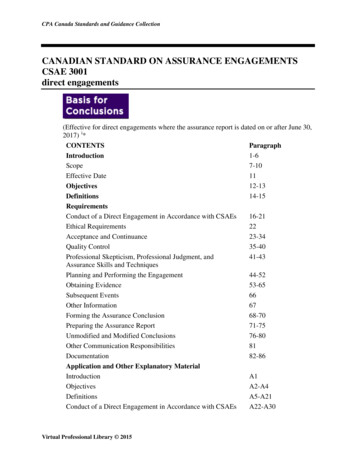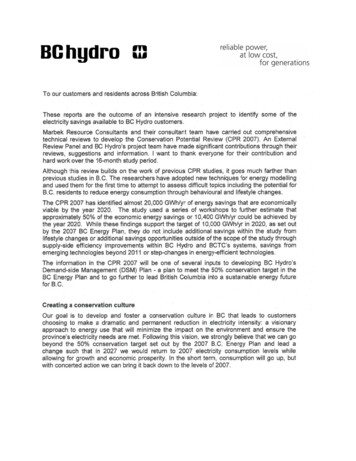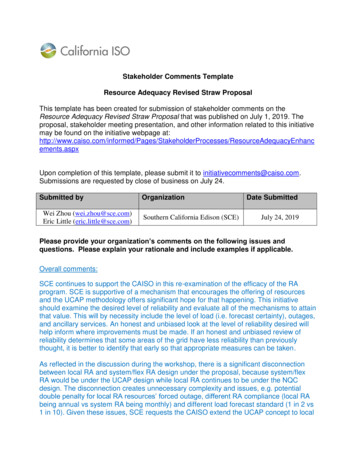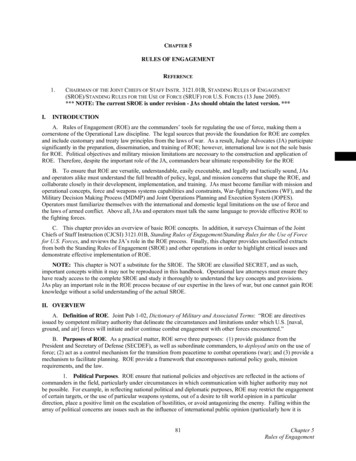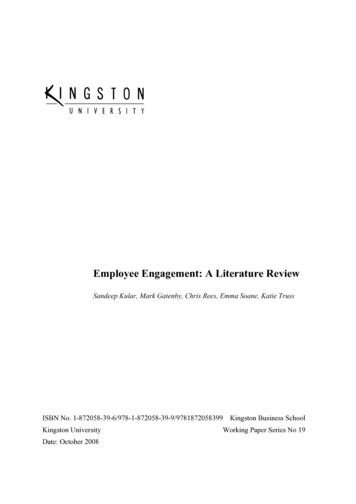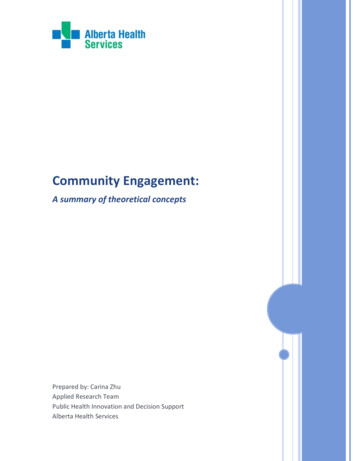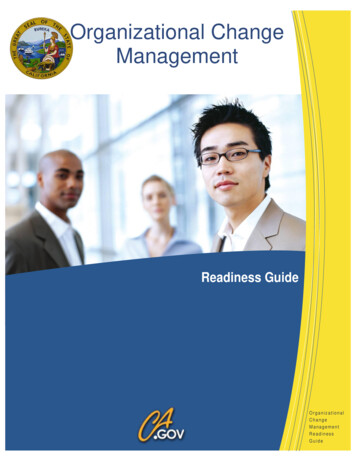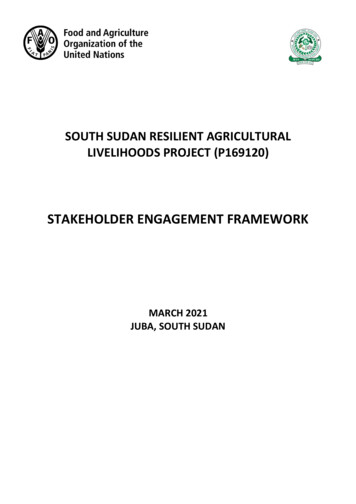
Transcription
SOUTH SUDAN RESILIENT AGRICULTURALLIVELIHOODS PROJECT (P169120)STAKEHOLDER ENGAGEMENT FRAMEWORKMARCH 2021JUBA, SOUTH SUDAN
South Sudan Resilient Agricultural Livelihoods Project (P169120): Stakeholder Engagement FrameworkTable of ContentsABBREVIATIONS AND ACRONYMS .31.INTRODUCTION .41.1 Project Locations.52.BRIEF SUMMARY OF STAKEHOLDER ENGAGEMENT ACTIVITIES DURING PROJECT DESIGN.73.STAKEHOLDER IDENTIFICATION AND ANALYSIS .93.1 Affected parties .93.2 Other Interested Parties .103.3 Disadvantaged / vulnerable individuals or groups .114.STAKEHOLDER ENGAGEMENT PROGRAM .184.1 Purpose and timing of stakeholder engagement program .184.2 Proposed strategy for information disclosure .184.3 Proposed strategy for consultation .204.4 Proposed strategy to incorporate the view of vulnerable groups .224.5 Timelines .224.6 Review and Integration of Stakeholder Consultations .235. RESOURCES AND RESPONSIBILITIES FOR IMPLEMENTING STAKEHOLDER ENGAGEMENTACTIVITIES .245.1 Resources .245.2 Management functions and responsibilities .246.GRIEVANCE MECHANISM.25These steps are summarised in Figure 2 below. Further information on the project GRM is detailedin the main text of the ESMF. .267.MONITORING AND REPORTING .307.1 Participatory Monitoring .307.2 Reporting back to stakeholder groups .31ANNEXES .322
South Sudan Resilient Agricultural Livelihoods Project (P169120): Stakeholder Engagement FrameworkABBREVIATIONS AND ccountability to Affected PopulationsBoma Development CommitteeCounty Agriculture DepartmentCivil Society OrganizationDirector GeneralEnvironmental and SocialEnvironmental and Social Commitment PlanEnvironmental and Social Management FrameworkEnvironmental and Social Management PlanEnvironmental and Social StandardFood and Agriculture Organization of the United NationsFragile, Conflict and ViolentFocus Group DiscussionGender-based ViolenceGrievance Redress MechanismHead of Field OfficeInternally Displaced PersonImplementing PartnerMinistry of Agriculture and Food SecurityMinistry of Finance and Economic PlanningNon-governmental OrganizationProject Coordination UnitPayam Development CommitteeProject Implementation UnitProject Management UnitProject Steering CommitteePersons with disabilitiesResilient Agricultural Livelihoods ProjectSexual Exploitation and AbuseStakeholder Engagement FrameworkStakeholder Engagement PlanTechnical Coordination CommitteeThird-party monitorUnited Nations Development ProgrammeUnited Nations Environment ProgrammeUnited Nations Population FundUnited Nations Children's FundUnited Nations Mission in South SudanUnited Nations Office for Project ServicesVoluntary land donationWorld Health Organization3
South Sudan Resilient Agricultural Livelihoods Project (P169120): Stakeholder Engagement Framework1. INTRODUCTIONThe World Bank’s ESS 10 recognizes the importance of open and transparent engagement with allproject stakeholders, based on the recognition that effective stakeholder engagement can improveenvironmental and social (E&S) sustainability of project activities, enhance project acceptance, andimplementation, and allow stakeholders to contribute to project design. The key objectives ofstakeholder engagement include an assessment of the level of interest and support of the project bystakeholders to promote effective and inclusive engagement with all project-affected parties and toensure that project information on E&S risks and impacts is disclosed in a timely and understandableway.The South Sudan Access to Information Act No. 65 of 2013 spells out that every citizen shall have theright of access to information. It focuses on the right to access information held by public bodies inSouth Sudan. The purpose of the Act is to give effect to the constitutional right of access toinformation, promote maximum disclosure of information in the public interest and establish effectivemechanisms to secure that right. The project shall adhere to the Act.The WB’s ESS10 also sets out that a borrower has to engage with stakeholders as an integral part of aproject’s environmental and social assessment and project design and implementation. The nature,scope and frequency of the engagement should be proportional to the nature and scale of the project.Consultations with stakeholders have to be meaningful and be based on stakeholder identificationand analysis, plans on how to engage stakeholders, disclosure of information, actual consultations, aswell as responses to stakeholder grievances and reporting back to stakeholders. Meaningfulstakeholder engagement throughout the project cycle is an essential aspect of good projectmanagement and provides opportunities for Borrowers to learn from the experience, knowledge, andconcerns of the affected and interested stakeholders, and to manage their expectations by clarifyingthe extent of the Borrower’s responsibilities and resources.This Stakeholder Engagement Framework (SEF) takes a framework approach as the exact projectlocations are yet to be identified. The SEF outlines the general principles and strategy for preparingStakeholder Engagement Plans (SEPs) consistent with ESS10, once specific locations are confirmed.This SEF is designed to anchor all stakeholder engagement in a systematic way for the South SudanResilient Agricultural Livelihoods Project (RALP). It lays out legal and policy requirements in regards tostakeholder engagements, lists engagements already undertaken, provides a stakeholderidentification and analysis of all relevant project-affected parties to the RALP and lays out means ofdissemination of information to different parties as well as means and ways to continue to consultdifferent stakeholder groups throughout the project cycle. Furthermore, it contains a monitoring planthat ensures the implementation of subsequent site specific SEPs. The SEF will therefore guide thedevelopment of activity-specific or area-specific SEPs), which will be developed once project locationsand subproject locations are confirmed to include and address the specific local conditions.This SEF is based on the guiding principles that stakeholder engagement should:- Be timely- Be independent (free of external manipulation, interference, coercion, discrimination,and intimidation)- Have clear objectives- Have the capacity to influence the stakeholders- Obtain feedback- Trigger provision of resources and other modifications, where needed- Be properly documented and disclosed by the borrower4
South Sudan Resilient Agricultural Livelihoods Project (P169120): Stakeholder Engagement Framework-Generate minutes from every meeting/interviewGenerate recordings or photos, if culturally acceptedOnce the project locations have been confirmed, the site-specific SEPs will be developed with thefollowing procedure as a guide:1. Classify Stakeholders. As an initial step in stakeholder analysis, classifying the stakeholdersinto defined groups can assist in the next, more detailed steps. This will focus on County level,with linkages to State or National level where appropriate.2. Develop a Power/Interest Grid to help in identifying stakeholders based on their power andinterest in the project. This will clarify the ability and extent of the stakeholder to stop and/orchange the project (power) who has high or low power to affect the project, and the amountof overlap the stakeholder’s interests have with the project, defining their “stake” in theproject. This is the primary stakeholder analysis tool.3. Define Power - analysis of the power of the stakeholder to get a sense of how much influencethey have, and therefore how much they need to be informed engaged throughout theproject.4. Define Interest – analysis to determine what the stakeholders’ interests in the project reallyare.5. Develop the Stakeholder Engagement Plan - the stakeholder communication needs areitemized based on the power and influence analysis. The type of communication and itsfrequency is specified.The site-specific SEPs will be prepared based on the criteria below:1. Provide guidance for stakeholder engagement such that it meets the standards ofInternational Best Practice while adhering to national, World Bank and internationalrequirements for consultation;2. Identify key stakeholders that are affected, and/or able to influence the Project and itsactivities;3. Identify the most effective methods, timing and structures through which to share projectinformation, and to ensure regular, accessible, transparent and appropriate consultation;4. Develop a stakeholders’ engagement process that provides stakeholders with an opportunityto influence project planning and design;5. Establish formal grievance/resolution mechanisms in line with traditional authorities for easeof acceptance and use;6. Define roles and responsibilities for the implementation of the SEP;7. Define reporting and monitoring measures to ensure the effectiveness of the SEP andperiodical reviews of the SEP based on findings.1.1 Project LocationsThe Project will target thirteen counties across nine states for implementation, planned in two phases.Tier 1 counties proposed for Phase 1 of the RALP are: Renk, Bor South, Magwi, Torit, Aweil East, AweilSouth, Wau, Jur River. Tier 2 counties proposed for Phase 2 are: Melut, Akobo, Twic East, Yei, andMaridi.Figure 1: Proposed Project Areas for the RALP5
South Sudan Resilient Agricultural Livelihoods Project (P169120): Stakeholder Engagement Framework6
South Sudan Resilient Agricultural Livelihoods Project (P169120): Stakeholder Engagement Framework2. BRIEF SUMMARY OF STAKEHOLDER ENGAGEMENT ACTIVITIES DURINGPROJECT DESIGNEngagements and consultation on the project design and the planned activities and implementationarrangements have been conducted with key stakeholders including the relevant Governmentagencies, and development partners such as UN agencies, as well as NGOs. Consultation withfarming households were carried out as part of the FSNMS survey that is used as an input for theRALP design. MAFS has also conducted consultations with the World Bank and FAO at the nationallevel, as per the table below.Table 1: Stakeholder Engagement Activities During RALP DesignStakeholder GroupLocationExpected RALP Project Engagement/InterestWorld Bank, FAO,and Ministry ofAgriculture and FoodSecurity (MAFS)World Bank office Juba(January 2020) andVirtual (April –November 2020)The World Bank is financing the projectFarmer households –during Food Securityand NutritionMonitoring System(FSNMS) surveyTorit CountyLivelihoods based on livestock rearing and agricultural activities.Project beneficiaries will benefit from Project interventions such astraining on good agricultural practices, provision of agriculturalinputs, provision of grants for productive assets and constructionof community facilities.Concerns around conflict between herdsmen and crop growerswill need to be addressed as the project seeks to increase landunder cultivation.Farmer households –during Food Securityand NutritionMonitoring System(FSNMS) surveyWauLivelihoods based on agriculture, supplemented by seasonalfishing. Project beneficiaries will benefit from Projectinterventions such as training on good agricultural practices,provision of agricultural inputs, provision of grants for productiveassets and construction of community facilities.MAFS is the Borrower and Project ManagerFAO is the lead technical partner and will provide key technicalassistance and capacity building support.Farmers will benefit from capacity building on integrated pestmanagement and pest and disease resistant crop varieties, ascrop pests and diseases pose a significant challenge foragricultural production.Farmer households –during Food Securityand NutritionMonitoring System(FSNMS) surveyAweilLivelihoods based on livestock rearing, agricultural activities andfishing. Project beneficiaries will benefit from Projectinterventions such as training on good agricultural practices,provision of agricultural inputs, provision of grants for productiveassets and construction of community facilities.7
South Sudan Resilient Agricultural Livelihoods Project (P169120): Stakeholder Engagement FrameworkFarmers will benefit from capacity building on water harvestingand climate-smart agriculture planning tools and technologiesto strengthen their capacity for addressing climate-relatedevents such as floods and droughts.MAFS plans to undertake consultations with representative communities in selected counties, oncethe final project locations have been confirmed, by organizing community awareness and consultationmeetings, interviews with community leaders, and focus group discussions (FGDs) with particulargroups (women, youth, internally displaced persons,) where possible, with full observation ofGovernment Covid-19 protocols.National-level consultations mainly resulted in agreements over the scope of the project, in particularthat it will address the enhancement of agricultural production capacity in project areas, whilestrengthening national and county institutions’ capacity to provide long-term support for thesustainable growth of the agricultural sector via policy reforms and extension services. During theconsultation, the project’s criteria for geographical targeting was endorsed with the agreement thatnot all areas may meet all the criteria fully, and there will be a need to balance needs and opportunitiesversus anticipated challenges in various locations. The team developed a targeting index whichaggregates the following six indicators: (i) need (ii) potential for agricultural production; (iii) access; (iv)equity; (v) catalytic and complementary programmes; and (vi) footprint of service providers.Accordingly, targeted data (coordination, need, potential, connectivity and security) will be used toidentify priority counties and payams which are safe for implementation.The mission also agreed on the following key features: (i) focus on gender (both gender empowermentand gender-based violence mitigation) and youth; (ii) focus on capacity development at household andfarmer organisation levels; (iii) strong technical assistance and capacity building activities for MAFS tosupport the creation of a more enabling environment in terms of policy and technical knowledge; and(iv) focus on low-hanging fruit since the project budget and period is not as much as required to trulytransform agricultural production in the country.Agreements were made to finance “quick wins” to deliver tangible results quickly and help build themomentum of the project. It was agreed that the final “quick wins” will be selected based onvulnerability and available budget. The combination of “quick wins” and vulnerable counties allowsthe project to benefit both stable and conflict-affected areas.Further location-specific consultations will be carried out to identify and address their unique needs,including the use of sex-disaggregated surveys and focus groups, and vulnerability-based selectioncriteria to prioritize their inclusion as project beneficiaries. Results of the consultations have beenintegrated into the design of the project and the development of the Environmental and SocialManagement Framework (ESMF).8
South Sudan Resilient Agricultural Livelihoods Project (P169120): Stakeholder Engagement Framework3. STAKEHOLDER IDENTIFICATION AND ANALYSISStakeholder engagement is the interaction with, and influence of project stakeholders to the overallbenefit of the project and its advocates. ESS10 recognizes two broad categories of stakeholders: 1)those likely to be affected by the project because of actual impacts or potential risks to their physicalenvironment, health, security, cultural practices, well-being, or livelihoods (project affected parties),and 2) other interested parties.In view of the RALP, affected parties will likely be in the thirteen counties proposed for projectimplementation, planned in two phases as discussed above.Among these affected parties, beneficiaries will be identified through transparent communityparticipation with verification being done by an independent third-party monitor. While not everyaffected party will also be a beneficiary, it is crucial to disseminate information and engage with allstakeholders on project modalities as well as on the selection criteria of beneficiaries in the affectedareas.3.1 Affected partiesEffective consultations and other stakeholder engagements with the project-affected communitieswill be conducted by the FAO Project Management Unit (PMU), through Project Implementation Units(PIUs), with oversight from the MAFS Project Coordination Unit (PCU), once the implementingagencies have been engaged and throughout implementation.Table 2: Directly or Indirectly Project-Affected Parties1StakeholderSmall farmer and agropastoralist householdsComponentC1 / C2Small pastoralisthouseholdsC1 / C2IDPs, in particular, thosewho are persons withdisabilities, fromethnic/other minorities,and womenC1 / C2Host communitiesC1 / C2Expected RALP Project Engagement/InterestMost affected by low agricultural production andvulnerable livelihoods. Project interventions such astraining, provision of inputs, grants and construction ofcommunity facilities have significant impacts on them.They will need to be effectively consulted to mitigate E&Srisks and enhance project benefits.Households reliant on pastoralist livelihoods may interactwith farmer / agro-pastoralist households throughexpansion of areas under cultivation interfering with theirtraditional routes for tending livestock.Due to the internal conflict in the country, many peoplefled their home areas to more stable areas within thecountry for security reasons and would likely return totheir places of origin as soon as stability and security isrestored. Demand for basic services would increase.Among IDPs are persons who have suffered disabilities asa result of the conflict. The South Sudan HumanitarianNeeds Overview estimates a total of 1.3 million IDPs inneed nationally1.Often tension is reported between IDPs and their hostcommunities. In the thirteen respective counties there areseveral locations where IDPs meet host communities. It istherefore important to also attend to the needs of hostcommunities.OCHA Humanitarian Needs Overview South Sudan 20209
South Sudan Resilient Agricultural Livelihoods Project (P169120): Stakeholder Engagement FrameworkWomen and girlsC1 / C2Widowsandfemale1.headed householdsC1 / C2YouthC1Returnees3.C1 / C2Ethnic minority groupsC1 / C2PotentialworkerscommunityC1 / C2Localcommunityleadershipincludingreligious leadersC1 / C22.4.Although women play a critical role in the maintenance ofhousehold livelihoods and provision of labor inagriculture, they generally have less access to productiveresources, services and employment opportunities.Women and girls in South Sudan suffer from significantdiscrimination, including in education, economicempowerment and public participation, and are subject towidespread Gender-based Violence (GBV), includingdomestic violence, gang rape and other abuses.Given that more men die in the protracted conflict inSouth Sudan, a continuous increase in widows and femaleheaded households is taking place. This has resulted inchanges of the intra-household roles. Widows in particularare often marginalizedand vulnerable in hostcommunities as well as among the IDP and returneepopulations.Being the largest demographic in South Sudan and facingsignificant vulnerability owing to the country context, theeffects of crisis and shocks disproportionately impact theyouth. This calls for their targeted inclusion andinvolvement in the project activities through consultationsand information disclosures. The Sudanese military as wellas other armed groups have regularly recruited largenumbers of boys as child soldiers and girls to performsexual and domestic services for armed combatants.Due to the internal conflict in the country many peoplefled the country for security reason and will likely returnas soon as stability and security is restored. Demand forbasic services is paramount. Among returnees are personswho have suffered disabilities as a result of the conflict.Some of these groups have suffered historicdiscrimination and economic and political marginalizationand also more recently, the brunt of the conflict. They willneed special attention.Within the communities, some individuals with some levelof education exist, but not enough to take up jobs in thecities. Therefore, they are important resources that couldbe used. The project will need to sensitively manageexpectations among affected communities in relation tothe actual numbers of persons who can be hired to workfor the project.With formal administration systems only developing andnon-existent in some areas, community leaders includingclan and religious leaders play a vital role in communityentry and the attainment and social license to operate.They need to be engaged in community consultation andthe endorsement of community decisions.3.2 Other Interested PartiesThese are stakeholders with an interest in the project activities or outcomes. Table 3 below identifies thesegroups and describes their expected project engagement.Table 3: Other interested parties10
South Sudan Resilient Agricultural Livelihoods Project (P169120): Stakeholder Engagement FrameworkStakeholder GroupExpected RALP Project Engagement/InterestMembers of the Boma BDCs and PDCs are semi-formal community institutions responsible forDevelopment Committees supporting the planning and implementation of local development initiatives,(BDCs)andPayam and therefore critical in community sensitization and in discussions on subDevelopment Committees project implementation.(PDCs)Apex farmers’ organisationsThese organisations represent farmers’ interests at State and County level,and are critical to aspects of cooperative mobilization and negotiation withgovernment for more enabling policies and frameworks.Ministry of Agriculture andFood Security (MAFS)Borrower/ Project Manager. MAFS will also receive capacity building support.Government ministries MAFS, Ministry of Financeand Economic Planning(MOFEP) and Governors ofparticipating statesThese Government representatives will comprise the Project SteeringCommittee (PSC), providing high-level oversight and overall guidance onproject implementation.International NGOs, local andnational CSOs and NGOsoperating in the agriculture,health, education, livelihoodsectorsWith most having invaluable experience in the successful delivery of a widerange of humanitarian services, their networks, delivery systems andknowledge of intricate community dynamics will need to be tapped for useby the project.LocalBusinessandConstruction CompaniesThese are local enterprises that will provide various input supplies andconstruction services.FAOLead technical partnerWorld BankDonorOther UN agencies andentities (UNMISS, UNICEF,UNFPA, UNDP, UNOPS,UNEP)All organisations working in project locations are stakeholders and closecoordination would add value e.g. security (UNMISS), GBV referral services(UNFPA)3.3 Disadvantaged / vulnerable individuals or groupsThese are stakeholders that are considered to face challenges in participation or accessing projectinformation, activities or benefits, by virtue of their circumstances. Table 4 below identifies thesegroups and describes the additional support they require.Table 4: Disadvantaged / vulnerable individuals or groupsVulnerableGroupWomengirlsandLimitations to participation in/consultationwith the ProjectThey are typically left out of decision-makingprocesses and political representation,leading to local and community-based11Additional support/resources to be madeavailable
South Sudan Resilient Agricultural Livelihoods Project (P169120): Stakeholder Engagement FrameworkFemaleheadedhouseholds/widowsdecisions that do not account for theirunique needs and capacities. This produces aripple effect on labor or economicopportunitiesandeducationalopportunities. Customary land tenuresystems block women from securing andowning property2. The risk of sexual violencenegatively affects women s ability to access Workthroughfemalecommunityincome and resources.representatives in the affected communities,to identify suitable venues and timing fordedicated consultations and support forWomen suffer greater food insecurity due to childcare. Provide safe spaces to discusstheir cultural and social roles as caregivers GBV-SEA and provide information onand they may forego or pass on food within Grievance Redress Mechanism (GRM) andfamilies. This places up to 80 percent of relevant referral pathways.displaced households at risk, as they arepredominantly female-headed. They are alsolimited in land tenure and access oung people have largely been excludedfrom political life, including through the agebased systems of authority that prevails insome parts of South Sudan. Approximately30 percent of them also do not have accessto education of economic activities,negatively affecting their capacity tocontribute towards agricultural productionand value chain services.Targeted consultation to enable meaningfulparticipation in the project implementation.Minorityethnic groupsThe RALP will work in areas that are bothgovernment and opposition-controlled,conflict-affected or have significant minoritypopulations. Ethnic minorities may occur atdifferent levels, in the state or even insidethe county. Here they may be dominated byauthorities from other groups and may havelittle decision-making power.Utilise PDCs and BDCs and other localcommunity representatives to identify andmobilise minority groups to participate inmeetings and consultations. Also providelocal language interpreters to ensureunderstanding and ability to give feedbackduring engagement.InternallyDisplacedPeople (IDPs)IDPs and refugees are likely to encounterchallenges in accessing land for cultivation oradopting to new livelihoods e.g. .They will be kept informed about meetingsand consultations via other communitymembers in the area, and potentiallythrough radio and social media. Meetingswill only be held during day time in view ofsecurity concerns.ReturneesReturnees going back to their places of originare also more likely to encountercompetition in accessing basic resources likeshelter and water, hindering their ability toparticipate in development activities.Utilise PDCs and BDCs and other localcommunity representatives to identify andmobilise minority groups to participate inmeetings and consultations.2Shelter NFI Cluster South Sudan (2017) “Key Housing, Land and Property (HLP) Issues in Urban Areas of SouthSudan”.12
South Sudan Resilient Agricultural Livelihoods Project (P169120): Stakeholder Engagement FrameworkPersons withdisabilities(PWD)andtheircaregiversThe main challenges faced by people withdisabilities are access to basic services suchas water, sanitation and hygiene anddiscriminationthathinderstheirparticipation in social, political and economiclife, including agricultural production.Women with disabilities experience higherlevels of physical, psychological and sexualviolence.All venues for consultations, workshops andmeetings should be selected with a view tofacilitate physical access for PWD. Wherenecessary avail sign-language interpreters.Vulnerable groups within the communities affected by the project will be further confirmed andconsulted through dedicated means, as appropriate, upon confirmation of project locations. Adescription of the methods of engagement that will be undertaken by
Define Power - analysis of the power of the stakeholder to get a sense of how much influence . BRIEF SUMMARY OF STAKEHOLDER ENGAGEMENT ACTIVITIES DURING . where possible, with full observation of Government Covid-19 protocols. National-level consultations mainly resulted i
